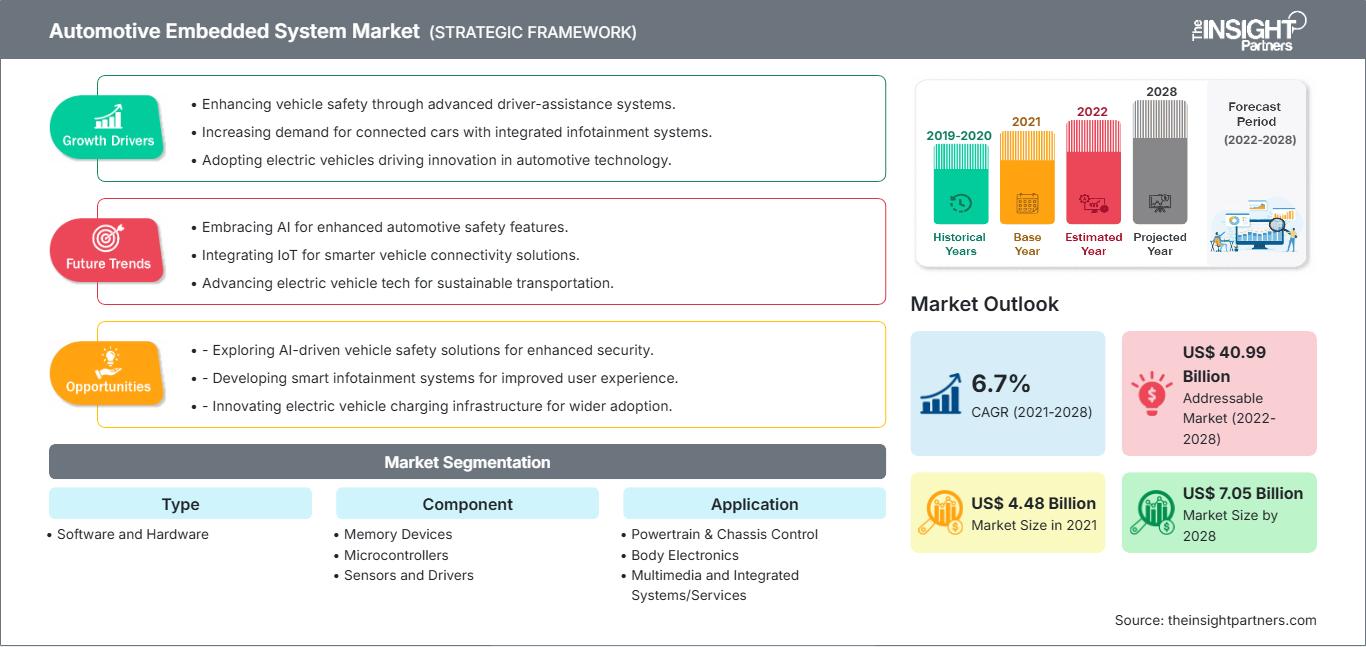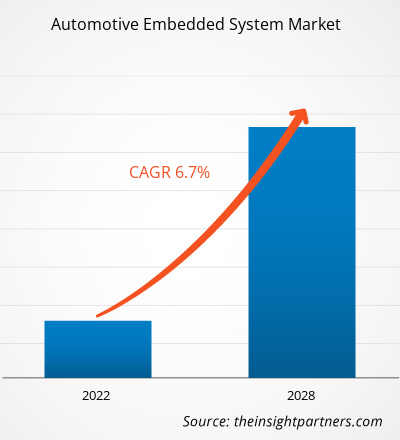자동차 임베디드 시스템 시장은 2021년 44억 8,381만 달러에서 2028년 70억 5,111만 달러로 성장할 것으로 예상되며, 2021년부터 2028년까지 연평균 6.7% 성장할 것으로 예상됩니다.
자동차 임베디드 시스템은 자동차에 내장되어 다양한 작업을 제어하는 컴퓨터화된 시스템입니다. 데이터 및 서비스 메커니즘을 제어하도록 설계되었습니다. 자동차 임베디드 시스템은 소프트웨어에 크게 의존합니다. 대부분의 자동차 임베디드 시스템은 에너지 절감 및 배출 감소, 높은 신뢰성 및 안전 기준 충족을 위해 사용됩니다. 또한 최종 사용자의 안전, 편의성 및 비용 기준을 충족하는 데에도 도움이 됩니다. 시스템 설계 및 소프트웨어 개발의 변화와 통합 서비스의 발전은 새로운 사업 전망을 열어줄 것입니다.
요구 사항에 맞게 이 보고서를 사용자 정의하십시오.
이 보고서의 일부, 국가 수준 분석, Excel 데이터 팩을 포함하여 모든 보고서에 대한 사용자 정의를 무료로 받을 수 있을 뿐만 아니라 스타트업 및 대학을 위한 훌륭한 제안 및 할인을 이용할 수 있습니다
자동차 임베디드 시스템 시장: 전략적 통찰력

- 이 보고서의 주요 주요 시장 동향을 확인하세요.이 무료 샘플에는 시장 동향부터 추정 및 예측에 이르기까지 데이터 분석이 포함됩니다.
이 보고서의 일부, 국가 수준 분석, Excel 데이터 팩을 포함하여 모든 보고서에 대한 사용자 정의를 무료로 받을 수 있을 뿐만 아니라 스타트업 및 대학을 위한 훌륭한 제안 및 할인을 이용할 수 있습니다
자동차 임베디드 시스템 시장: 전략적 통찰력

- 이 보고서의 주요 주요 시장 동향을 확인하세요.이 무료 샘플에는 시장 동향부터 추정 및 예측에 이르기까지 데이터 분석이 포함됩니다.
전 세계적으로 전기 자동차에 대한 수요가 증가하고, 오염 감소 및 연비 향상 효과로 인해 전기 및 하이브리드 자동차에 내장된 시스템 도입이 증가함에 따라 예측 기간 동안 글로벌 자동차 내장 시스템 시장이 성장할 것으로 예상됩니다. 자동차 안전 기능에 대한 고객의 관심 증가, 자동차 부문의 자동화 확대, 그리고 배출가스 제한 및 연비 향상을 위한 정부의 노력은 예측 기간 동안 자동차 내장 시스템 시장의 성장을 촉진할 것으로 예상됩니다. 또한, 커넥티드카에 대한 수요 증가와 차량 내 센서 및 엔지니어링 시스템 수요 증가는 향후 몇 년간 시장 성장을 견인할 것으로 예상됩니다.
교통수단의 전기화는 21세기의 주요 발전 중 하나였습니다. Forbes에 따르면, 전기 자동차(EV)의 글로벌 판매량은 2017년에서 2018년 사이에 65% 증가하여 210만 대에 달했고, 판매량은 2019년에도 안정적으로 유지되었습니다. 전 세계 정부는 전기 자동차 사용을 장려하기 위해 다양한 정책을 도입하고 이니셔티브를 취하고 있습니다. 인도의 하이브리드 및 전기 자동차의 빠른 도입 및 제조(FAME) 계획, 캘리포니아의 제로 배출 차량 프로그램, 유럽 연합의 친환경 자동차 이니셔티브와 같은 프로그램은 보조금, 세금 감면 및 기타 인센티브를 제공하여 전기 자동차 도입을 장려합니다. 많은 정부가 민간 기업과 협력하여 충전 인프라를 구축하는 여러 프로젝트도 시작했습니다. 이러한 활동은 글로벌 전기 자동차 산업의 성장에 기여하여 이러한 자동차 제조에 내장된 시스템에 대한 수요를 늘립니다. 연료 가격 상승과 전 세계 화석 연료 매장량 고갈로 인해 재생 에너지원으로의 전환이 촉진되고 있습니다. 자동차 제조업체는 더 큰 매력을 지닌 새로운 전기 자동차 모델을 생산하고 있습니다. 더욱이, 상용차 소유주들은 비용 절감의 이점을 누리기 위해 기존 차량을 전기차로 교체하고 있습니다. 전기차 비용 감소는 글로벌 전기차 산업을 활성화하고 있으며, 이는 다시 자동차 임베디드 시스템 시장 성장을 촉진하고 있습니다.
COVID-19 팬데믹이 자동차 임베디드 시스템 시장에 미치는 영향
COVID-19 팬데믹은 자동차 가치 사슬 전반에 걸친 수요와 공급 차질로 인해 2020년 글로벌 자동차 임베디드 시스템 시장의 전반적인 성장률에 어느 정도 부정적인 영향을 미쳤습니다. 그러나 백신 접종 활동의 급격한 증가와 COVID-19 안전 프로토콜의 지속적인 업데이트로 인해 정부 규제가 완화되고 있으며, 이는 민간 및 차체 전자 장치 생산 능력을 향상시켜 예측 기간 동안 자동차 임베디드 시스템 시장 성장을 정상화할 것으로 예상됩니다.
시장 분석
인포테인먼트 수요 증가로 자동차 임베디드 시스템 시장 성장 견인
모빌리티 산업의 변화와 함께, 인포테인먼트 시스템의 범위는 차량 탑승자에게 더욱 강화된 안전 기능, 추가 기능, 그리고 다양한 엔터테인먼트를 제공하기 위해 확장되고 있습니다. 스마트폰 연결을 통해 사용자는 Wi-Fi 및 블루투스 연결을 통해 메시지와 정보에 액세스할 수 있어 이동 중에도 더욱 쉽게 작업할 수 있습니다. 이러한 인포테인먼트 시스템은 디지털 어시스턴트, 여러 화면, 그리고 다양한 입력 방식을 통해 차량 내 디지털 경험을 제공합니다. 디지털 인터페이스 통합을 통해 자동차 공급업체와 OEM은 실시간 데이터를 더욱 적합한 방식으로 표시하는 인터페이스를 개발할 수 있습니다. 디지털 인터페이스는 더욱 광범위한 기능을 제공하여 제조업체가 ADAS를 포함한 여러 안전 필수 기능을 수행할 수 있도록 합니다.
유형별 세그먼트 분석
임베디드 시스템은 하드웨어와 소프트웨어 구성 요소의 조합으로, 자동차 산업에서 특정 작업을 수행하도록 설계된 마이크로프로세서 또는 마이크로컨트롤러를 기반으로 합니다. 자동차 임베디드 소프트웨어를 통해 운전자는 확장 가능한 데이터를 기록하여 차량 성능 및 운전자 행동에 대한 중요한 통찰력을 얻을 수 있습니다. 임베디드 자동차 소프트웨어 솔루션은 유지 보수 요구 사항을 예측하고 자동차 사고를 예방하는 데 도움이 됩니다. 또한, 커넥티드 자동차의 등장으로 자동차 기업들은 차량과 모빌리티 생태계 간의 격차를 메우고 차량 내 및 차량 외 데이터를 기반으로 차량 성능을 더욱 향상시키기 위해 임베디드 자동차 소프트웨어 개발 역량을 향상시켜야 하는 상황에 직면하고 있습니다. 기업들은 전방위적인 지원을 제공하는 새로운 소프트웨어 솔루션을 출시하고 있습니다. Intellias는 멀티미디어 시스템, 차량 내 네트워크, 텔레매틱스, ADAS, 차체 전자 장치, 파워 트레인 ECU 및 변속기 ECU 구성 요소의 작동을 개선하는 임베디드 소프트웨어 서비스를 제공합니다. 이 회사는 방대한 지식을 바탕으로 ASPICE 인증 방식을 기반으로 ECU 펌웨어 업데이트, 텔레매틱스 제어 장치 소프트웨어, 차량 추적 시스템, 파워트레인 컨트롤러 소프트웨어 및 기타 유사 시스템 및 구성 요소를 위한 복잡한 시스템을 설계합니다.
구성 요소 부문 분석
자동차 임베디드 시스템 시장은 구성 요소를 기준으로 메모리 장치, 마이크로컨트롤러, 센서 및 드라이버로 구분됩니다. 자동차 센서는 오일 압력, 온도, 오염도, 냉각수량 및 기타 변수를 조절하고 처리하는 데 사용할 수 있는 인지 센서입니다. 자동차에는 여러 유형의 센서가 사용되지만, 그 작동 방식을 이해하는 것이 매우 중요합니다. 다양한 회사에서 애플리케이션 요구 사항에 따라 고급 센서를 제공하고 있습니다. 이러한 센서는 차량 기능 관리, 적응 및 반응에 필요한 데이터를 수집하여 차량의 안전성, 편의성 및 효율성을 향상시키는 데 사용할 수 있습니다. 센서와 드라이버는 자동차, 트럭, 버스, 오프로드 차량을 포함한 다양한 현대 차량의 신경계에 사용됩니다. TE의 자동차 센서는 엄격한 기준에 따라 설계 및 제조되며, 주로 맞춤형으로 제공됩니다.
애플리케이션 세그먼트 분석
자동차 임베디드 시스템 시장은 애플리케이션별로 파워트레인 및 섀시 제어, 차체 전자 장치, 멀티미디어 및 통합 시스템/서비스로 구분됩니다. 자동차 멀티미디어 및 통합 시스템(MIDS)은 오디오 또는 비디오 엔터테인먼트를 제공하는 하드웨어와 소프트웨어의 조합입니다. 자동차 내비게이션 시스템, 비디오 플레이어, USB 및 블루투스 연결, 카컴퓨터, 차량 내 인터넷, Wi-Fi는 라디오 플레이어, 카세트 또는 CD 플레이어와 호환되는 주요 차량 내 엔터테인먼트 시스템 중 일부였습니다. ICE 시스템은 이제 간단한 대시보드 노브와 다이얼 외에도 스티어링 휠 오디오 컨트롤, 핸즈프리 음성 제어, 터치식 프리셋 버튼, 고급 기기의 터치 디스플레이를 탑재할 수 있습니다.
자동차 임베디드 시스템 시장 참여자들은 경쟁사와의 경쟁을 위해 첨단 기술과 기능을 통합하여 신제품 혁신과 개발에 집중하고 있습니다. 2021년 1월, DENSO Corporation과 Qualcomm Incorporated의 자회사인 Qualcomm Technologies, Inc.는 차세대 운전석 기술에 대한 협력을 발표했습니다. DENSO는 통합 운전석 시스템 및 차량용 인포테인먼트 제품의 사용성을 높이고 이러한 시스템을 위한 차량용 솔루션 기술을 개발할 것입니다.
유형별 자동차 임베디드 시스템 시장
- 소프트웨어
- 하드웨어
구성요소별 자동차 임베디드 시스템 시장
- 메모리 장치
- 마이크로컨트롤러
- 센서 및 드라이버
애플리케이션별 자동차 임베디드 시스템 시장
- 파워트레인 및 섀시 제어
- 차체 전자 장치
- 멀티미디어 및 통합 시스템/서비스
자동차 임베디드 시스템 시장 - 지역별
- 북미
- 미국
- 캐나다
- 멕시코
- 유럽
- 프랑스
- 독일
- 이탈리아
- 영국
- 러시아
- 유럽의 나머지 지역
- 아시아 태평양(APAC)
- 중국
- 인도
- 한국
- 일본
- 호주
- APAC의 나머지 지역
- 중동 및 아프리카(MEA)
- 남아프리카공화국
- 사우디아라비아
- UAE
- MEA 나머지 지역
- 남아메리카(SAM)
- 브라질
- 아르헨티나
- SAM 나머지 지역
자동차 임베디드 시스템 시장 지역별 통찰력
The Insight Partners의 분석가들은 예측 기간 동안 자동차 임베디드 시스템 시장에 영향을 미치는 지역별 동향과 요인들을 면밀히 분석했습니다. 이 섹션에서는 북미, 유럽, 아시아 태평양, 중동 및 아프리카, 그리고 중남미 지역의 자동차 임베디드 시스템 시장 부문 및 지역별 현황도 살펴봅니다.
자동차 임베디드 시스템 시장 보고서 범위
| 보고서 속성 | 세부 |
|---|---|
| 시장 규모 2021 | US$ 4.48 Billion |
| 시장규모별 2028 | US$ 7.05 Billion |
| 글로벌 CAGR (2021 - 2028) | 6.7% |
| 이전 데이터 | 2019-2020 |
| 예측 기간 | 2022-2028 |
| 다루는 세그먼트 |
By 유형
|
| 포함된 지역 및 국가 | 북미
|
| 시장 선도 기업 및 주요 회사 프로필 |
|
자동차 임베디드 시스템 시장 참여자 밀도: 비즈니스 역학에 미치는 영향 이해
자동차 임베디드 시스템 시장은 소비자 선호도 변화, 기술 발전, 그리고 제품 이점에 대한 인식 제고 등의 요인으로 인한 최종 사용자 수요 증가에 힘입어 빠르게 성장하고 있습니다. 수요가 증가함에 따라 기업들은 제품 및 서비스 확장, 소비자 니즈 충족을 위한 혁신, 그리고 새로운 트렌드를 적극 활용하고 있으며, 이는 시장 성장을 더욱 가속화하고 있습니다.

- 을 얻으세요 자동차 임베디드 시스템 시장 주요 주요 플레이어 개요
자동차 임베디드 시스템 시장 - 회사 프로필
- Continental AG
- Denso Corporation
- Garmin Ltd.
- Harman International
- INFINEON TECHNOLOGIES AG
- Mitsubishi Electric Corporation
- NXP Semiconductors
- Panasonic Corporation
- Robert Bosch GmbH
- System Controls Technology Solutions Pvt. Ltd.
- 과거 분석(2년), 기준 연도, CAGR을 포함한 예측(7년)
- PEST 및 SWOT 분석
- 시장 규모 가치/거래량 - 글로벌, 지역, 국가
- 산업 및 경쟁 환경
- Excel 데이터세트
최근 보고서
관련 보고서
사용 후기
구매 이유
- 정보에 기반한 의사 결정
- 시장 역학 이해
- 경쟁 분석
- 고객 인사이트
- 시장 예측
- 위험 완화
- 전략 기획
- 투자 타당성 분석
- 신흥 시장 파악
- 마케팅 전략 강화
- 운영 효율성 향상
- 규제 동향에 발맞춰 대응




















 무료 샘플 받기 - 자동차 임베디드 시스템 시장
무료 샘플 받기 - 자동차 임베디드 시스템 시장